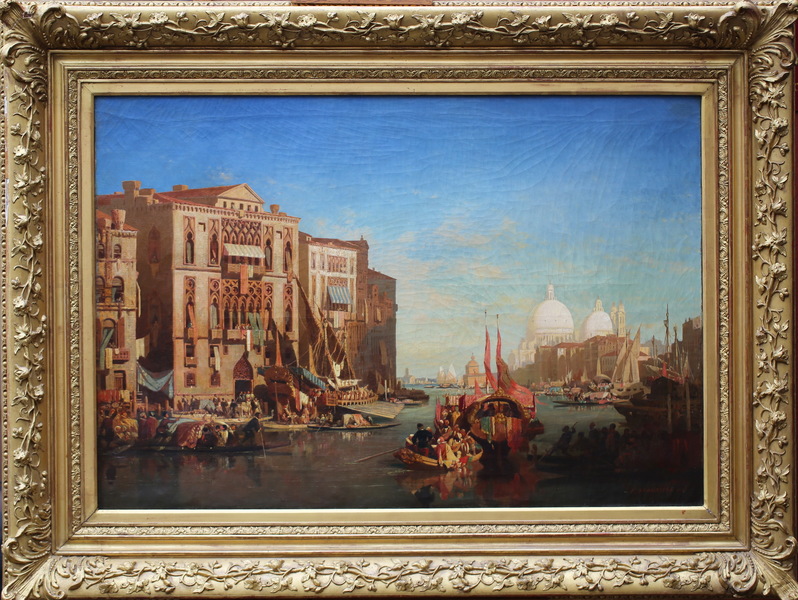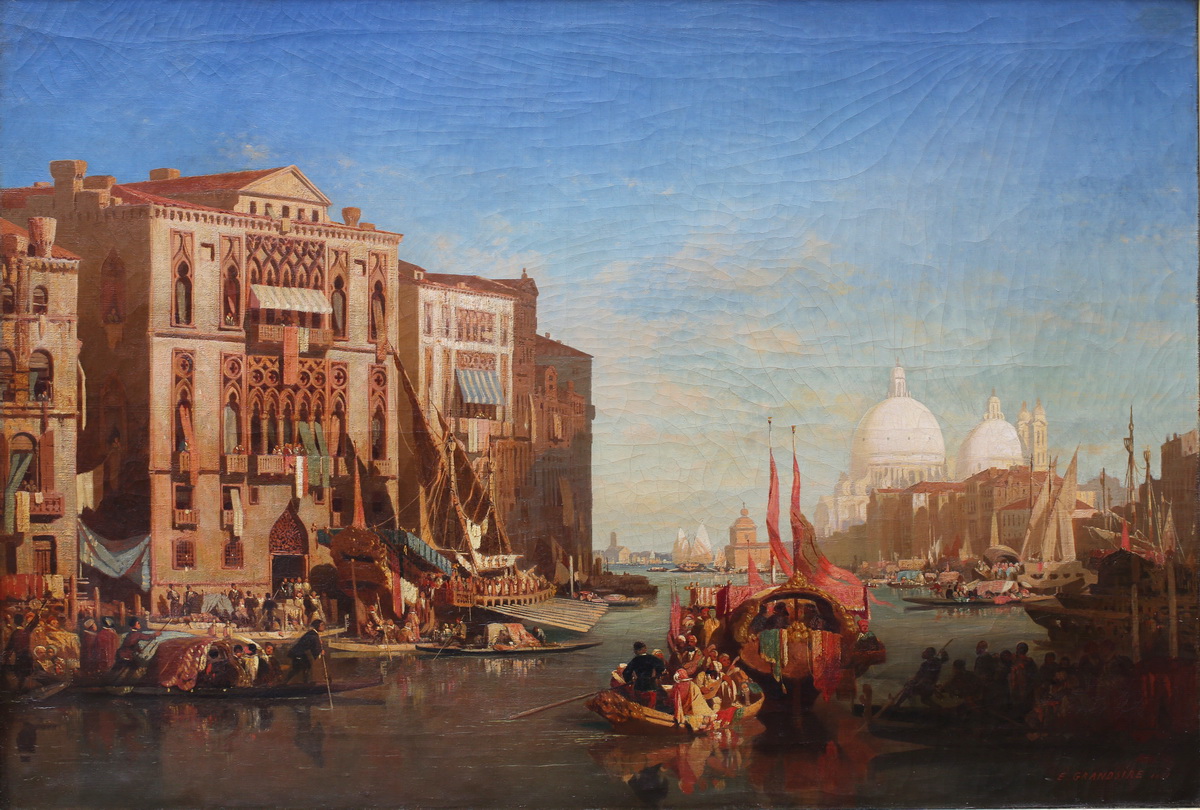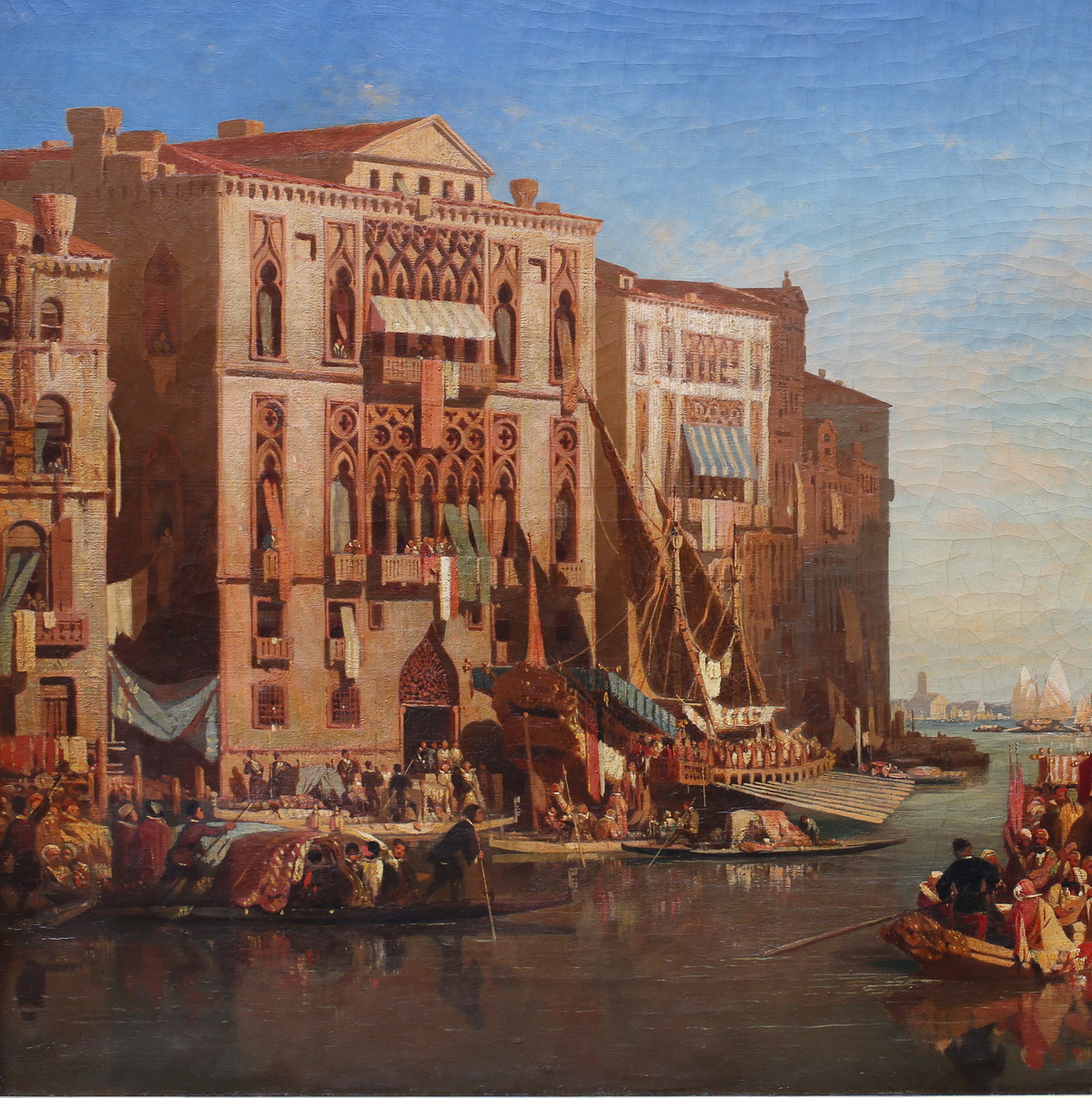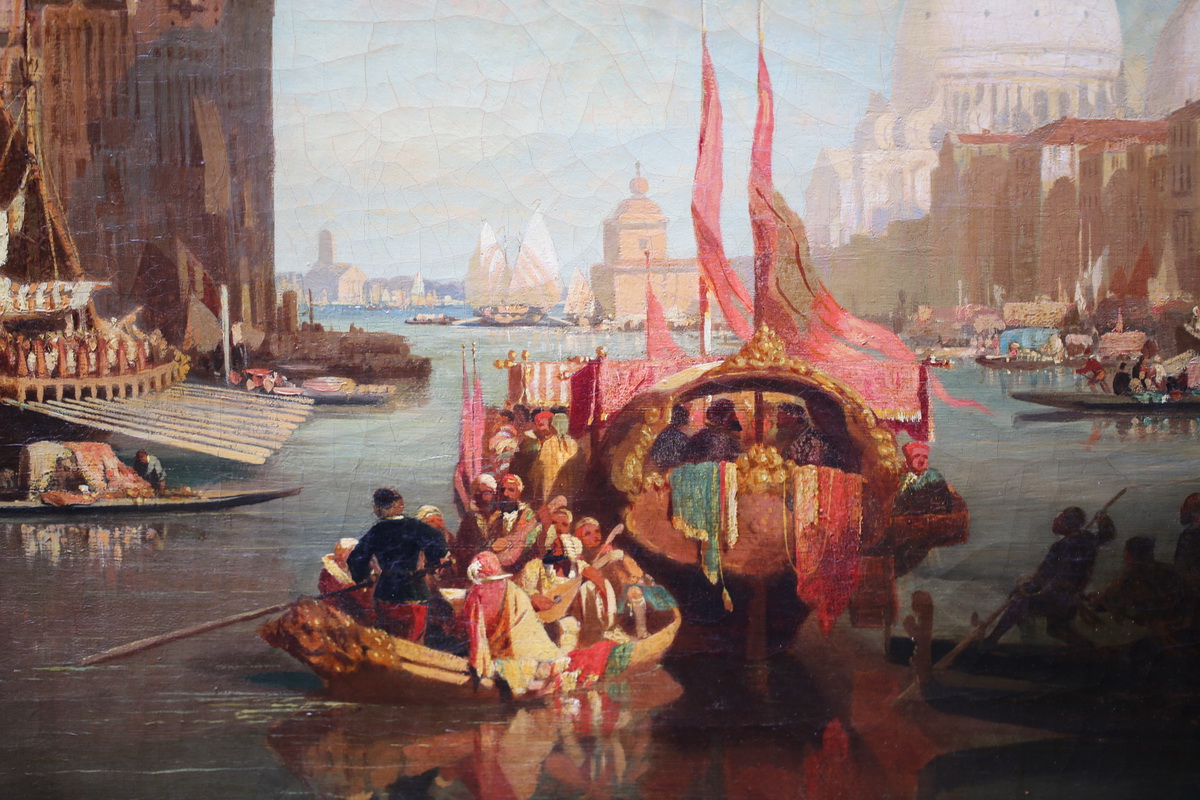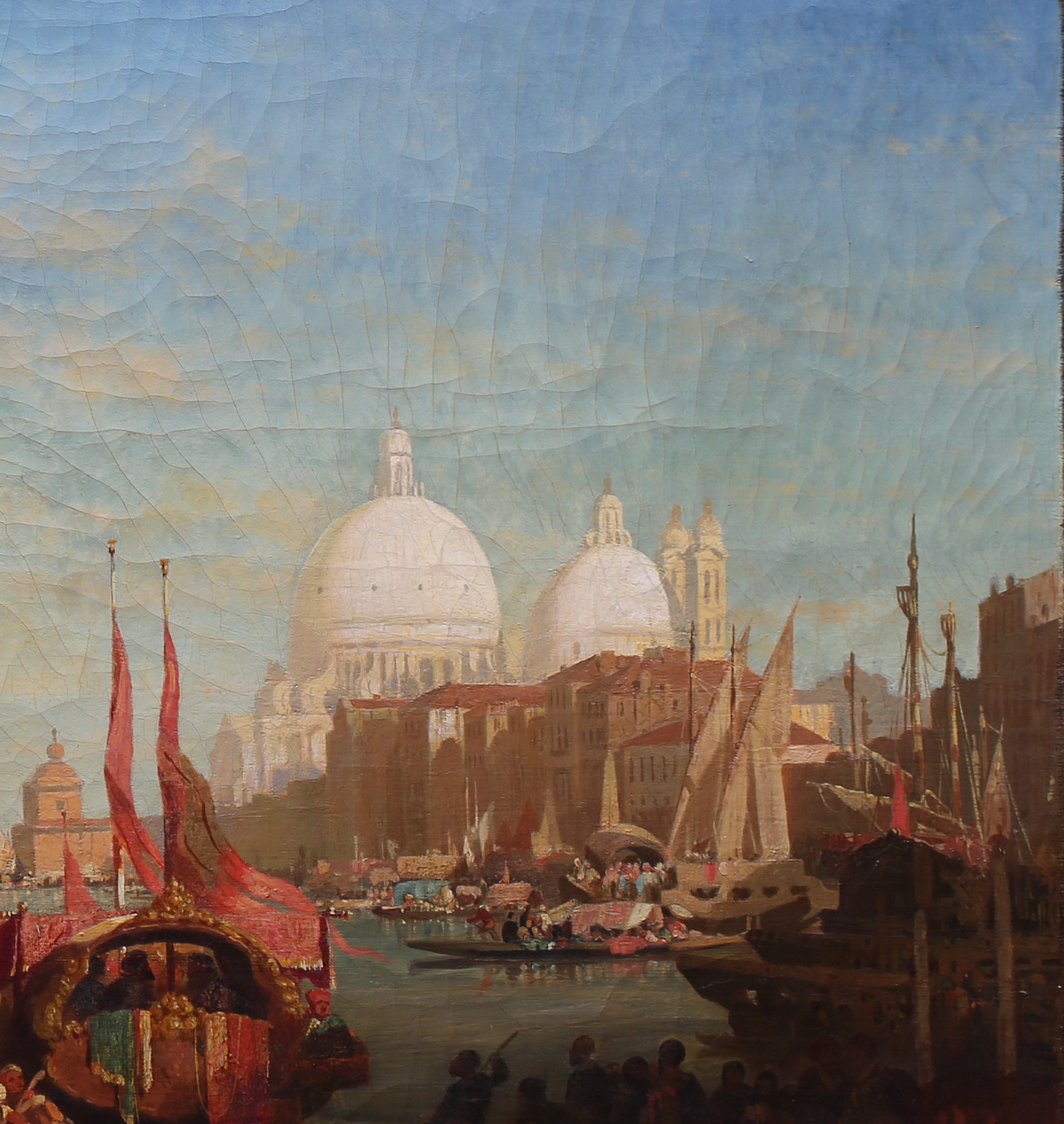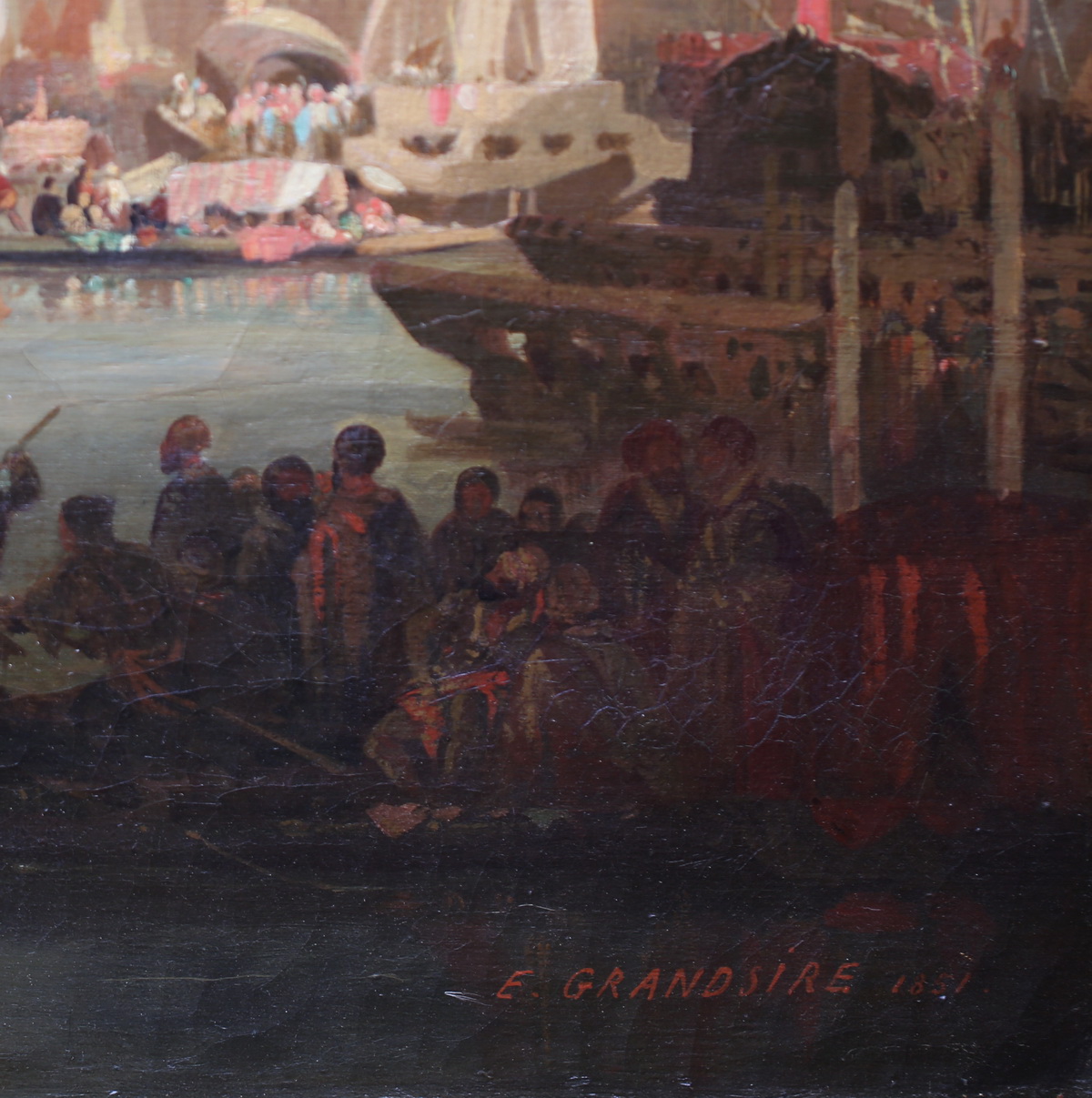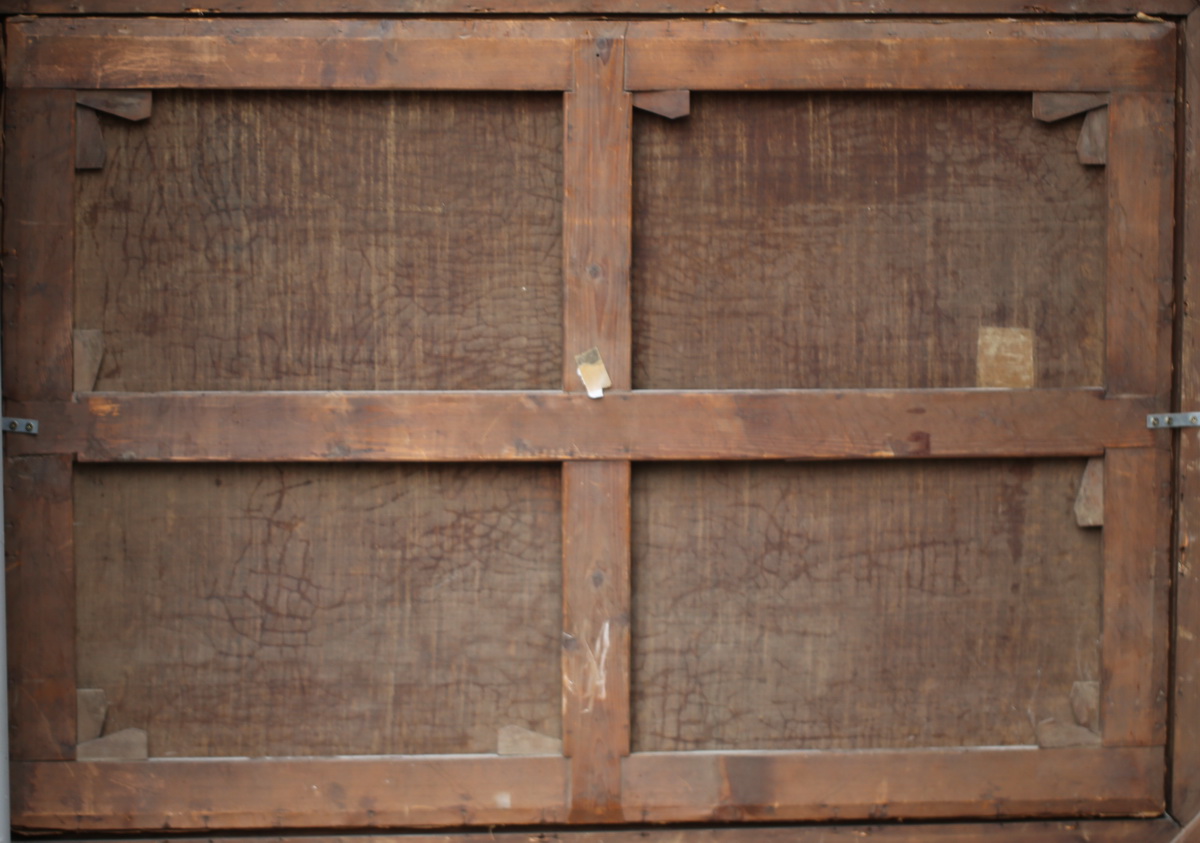> Home > Century XIX th painting > Pierre Eugène GRANDSIRE (1825-1905)
Pierre Eugène GRANDSIRE (1825-1905)
Reference : A1290-0188
Pierre Eugène GRANDSIRE (1825-1905) "Cavalli Palace belonging to the Count of Chambord, the latter on the balcony, the Grand Canal and the Salute to Venice" in 1851 oil on canvas dated 1851 and signed lower right, important frame in gilded stucco (153x116 cm)
Lemercier lithograph published in the Album of the exile. Residences of the elder branch of the Bourbons since 1830 (Paris, Bertin, 1850), for which our watercolor is preparatory.
- Work exhibited at the Salon of 1852 under No. 577 and titled The Cavalli Palace and the Church of Salute on the Grand Canal, in Venice.
History: Pupil of the Barbizon landscape architect Jules Dupré and of the marinist Jules Noël, Grandsire published in 1850 an album of exile in which he represents the residences (in Austria, Bohemia, Scotland...) Occupied by the royal family of the Bourbons since 1830 Among the 15 lithographs, the last two were about Venice.
The Vendramin-Calergi palace, located towards the Rialto bridge, has been the property of the Duchess of Berry since 1844.
The Cavalli Palace, located further downstream, just before Ponte Nuovo and opposite the Academia, belonged to his son the Count of Chambord. He had known the place several times when the Archduke Frederick of Austria owned it. Chambord used to stay at the Danieli Hotel when he came to Venice (then known as the "Jerusalem of the Royalists"). But just after his marriage in November 1846 to Marie-Thérèse (archduchess of Austria-East, eldest daughter of the Duke of Modena), he bought the Palazzo Cavalli, and spent every winter there until 1866, when Venice was annexed to the Kingdom of Italy. It was in this palace that he learned, for example, of the fall of Louis-Philippe in February 1848. His wife notably transformed the balcony gallery into a winter garden, filled with magnolia and oleanders; himself, following the destruction of the neighboring house on the left (our watercolor dates from before this destruction), created an adjoining garden, a luxury quite rare in Venice. It was on his balcony, with the Salute in the background, that Chambord was portrayed by Adeodato Malatesta (1806-1891), a work now kept at the Ducal Palace in Modena.
Built in the 16th century, the Cavalli palace was a vast building, but compared to the Vendramin palace, its furnishings were quite poor. The count nevertheless received there often, helped by relatives such as the Duke and Duchess of Levis, Monsieur de Monti or Madame de Chabanes.
In 1877 the new owner was Baron Raimondo Franchetti of Turin; around 1896 he commissioned the Milanese architect Camillo Boito to restore it completely. The palace was sold to the city of Venice in 1922, and is today the seat of the Venetian Institute of Science, Letters and Arts. Eugène Grandsire had a career as a landscape designer and illustrator, collaborating with newspapers such as L'Illustration and Le Magasin Pittoresque, and exhibiting nearly fifty works at the Salon. Notably a specialist in charcoal, he was a drawing teacher at the war school and attended the George Sand circle at Nohant for a time.
Domiciled at 25 quai voltaire in Paris, he also had Queen Victoria as a sponsor.
Present in Venice at the end of the 1840s, Grandsire realized several views, such as The port of Venice from the public gardens (exhibited at the Salon of 1852 and 1859), or The Erbaria market near the Rialto bridge (gouache watercolor , 20 x 30.5 cm), kept at the Musée des Beaux-Arts in Quimper.
Pierre Eugène GRANDSIRE (1825-1905) "Cavalli Palace belonging to the Count of Chambord, the latter on the balcony, the Grand Canal and the Salute to Venice" in 1851 oil on canvas dated 1851 and signed lower right, important frame in gilded stucco (153x116 cm)
Lemercier lithograph published in the Album of the exile. Residences of the elder branch of the Bourbons since 1830 (Paris, Bertin, 1850), for which our watercolor is preparatory.
- Work exhibited at the Salon of 1852 under No. 577 and titled The Cavalli Palace and the Church of Salute on the Grand Canal, in Venice.
History: Pupil of the Barbizon landscape architect Jules Dupré and of the marinist Jules Noël, Grandsire published in 1850 an album of exile in which he represents the residences (in Austria, Bohemia, Scotland...) Occupied by the royal family of the Bourbons since 1830 Among the 15 lithographs, the last two were about Venice.
The Vendramin-Calergi palace, located towards the Rialto bridge, has been the property of the Duchess of Berry since 1844.
The Cavalli Palace, located further downstream, just before Ponte Nuovo and opposite the Academia, belonged to his son the Count of Chambord. He had known the place several times when the Archduke Frederick of Austria owned it. Chambord used to stay at the Danieli Hotel when he came to Venice (then known as the "Jerusalem of the Royalists"). But just after his marriage in November 1846 to Marie-Thérèse (archduchess of Austria-East, eldest daughter of the Duke of Modena), he bought the Palazzo Cavalli, and spent every winter there until 1866, when Venice was annexed to the Kingdom of Italy. It was in this palace that he learned, for example, of the fall of Louis-Philippe in February 1848. His wife notably transformed the balcony gallery into a winter garden, filled with magnolia and oleanders; himself, following the destruction of the neighboring house on the left (our watercolor dates from before this destruction), created an adjoining garden, a luxury quite rare in Venice. It was on his balcony, with the Salute in the background, that Chambord was portrayed by Adeodato Malatesta (1806-1891), a work now kept at the Ducal Palace in Modena.
Built in the 16th century, the Cavalli palace was a vast building, but compared to the Vendramin palace, its furnishings were quite poor. The count nevertheless received there often, helped by relatives such as the Duke and Duchess of Levis, Monsieur de Monti or Madame de Chabanes.
In 1877 the new owner was Baron Raimondo Franchetti of Turin; around 1896 he commissioned the Milanese architect Camillo Boito to restore it completely. The palace was sold to the city of Venice in 1922, and is today the seat of the Venetian Institute of Science, Letters and Arts. Eugène Grandsire had a career as a landscape designer and illustrator, collaborating with newspapers such as L'Illustration and Le Magasin Pittoresque, and exhibiting nearly fifty works at the Salon. Notably a specialist in charcoal, he was a drawing teacher at the war school and attended the George Sand circle at Nohant for a time.
Domiciled at 25 quai voltaire in Paris, he also had Queen Victoria as a sponsor.
Present in Venice at the end of the 1840s, Grandsire realized several views, such as The port of Venice from the public gardens (exhibited at the Salon of 1852 and 1859), or The Erbaria market near the Rialto bridge (gouache watercolor , 20 x 30.5 cm), kept at the Musée des Beaux-Arts in Quimper.
Dimensions :
Width : 46 inch, Height : 31 inch, height frame : 46 inch, Largeur cadre : 60 inch
Width : 46 inch, Height : 31 inch, height frame : 46 inch, Largeur cadre : 60 inch







